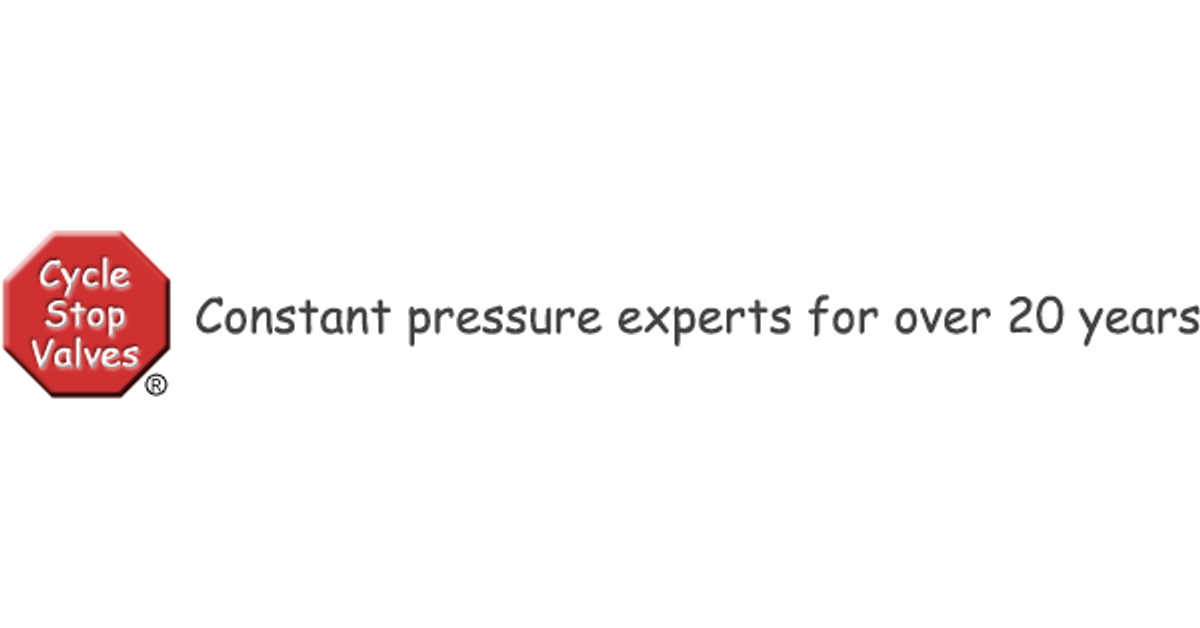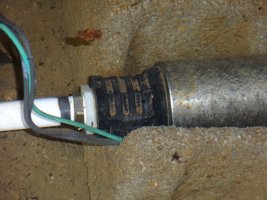TLDR: I am interested in installing a CSV, and this has prompted me to take a closer look at my system. Apparently, I will need to increase my pressure setting to use a CSV; this I have concerns about, not knowing the possible consequences. Any insights are welcome.
The components are old, but everything is currently working properly and cycling as expected. The system was already in place when I acquired the property 13 years ago. The water source is a spring in a ravine and is enclosed in a structure with the pump. All other equipment is in the basement of the house.
The pump is a 3-wire, 3/4-HP, 230-volt submersible, dated 2002, and positioned horizontally in a couple of feet of water. (It's probably a Franklin Electric, which is the label on the power supply box in the basement.) Based on a modern pump (Everbilt) of the same specs, I presume the following is the same:
-Designed for wells up to 100 ft. to 150 ft. deep
-Pumps 10 GPM
-Includes built-in check valve

Aside from the pump's own coarse screen, there is nothing to stop small debris or stirred sediment (dirty water) from going into the system. It happens, for example, when a deer crashes through the roof (see tarp above).
The pressure tank in the home's basement is a bladder type, 36 gallons, with a maximum pressure of 100 PSIG. I don't know how old it is, but it's a Wellsaver brand that apparently is now A. O. Smith.

There is no pressure relief valve (unless it's under the tank, which wouldn't make sense). I assume I should correct this. There is also no tank drain valve (which I suppose would provide a more complete emptying for pressure measurement).
The pressure switch is set at 30-50 psi. But, from the calculators on the CSV website, it seems there are no CSVs designed for my pressure range. 40-60 seems to be the minimum.
I do not know why the pressure switch is set to 30-50. I can only guess this was selected for one or more of the following reasons:
1) The flow rate of the spring itself? It is possible to empty the spring temporarily by continuous use for a long time, but this never happens with normal use.
2) The long distance to the house? The estimated distance between the pump and the house is 530 feet. The line rises out of the ravine with an elevation gain (depth) of about 20 feet at the highest point (around 380 feet) and then follows the land downward toward the house (falling about 5 feet).
3) To save electricity?
4) To provide more tank drawdown (9.89 versus 8.57 gallons)?
Beyond the pressure increase, I wonder how the old pump and pressure tank will respond to the new frequency/runtime dynamics that a CSV will impose. I have this superstition that old, worn, working machines don't like it when you make changes. I also wonder about the old electric water heater, and how it might respond to higher pressure.
Then there is the PVC line itself. It is old and has already demonstrated some brittleness in exposed portions. I would not want to deal with a break somewhere in the long, buried line.
Clearly, I don't fully understand the dynamics of all this.
The components are old, but everything is currently working properly and cycling as expected. The system was already in place when I acquired the property 13 years ago. The water source is a spring in a ravine and is enclosed in a structure with the pump. All other equipment is in the basement of the house.
The pump is a 3-wire, 3/4-HP, 230-volt submersible, dated 2002, and positioned horizontally in a couple of feet of water. (It's probably a Franklin Electric, which is the label on the power supply box in the basement.) Based on a modern pump (Everbilt) of the same specs, I presume the following is the same:
-Designed for wells up to 100 ft. to 150 ft. deep
-Pumps 10 GPM
-Includes built-in check valve
Aside from the pump's own coarse screen, there is nothing to stop small debris or stirred sediment (dirty water) from going into the system. It happens, for example, when a deer crashes through the roof (see tarp above).
The pressure tank in the home's basement is a bladder type, 36 gallons, with a maximum pressure of 100 PSIG. I don't know how old it is, but it's a Wellsaver brand that apparently is now A. O. Smith.
There is no pressure relief valve (unless it's under the tank, which wouldn't make sense). I assume I should correct this. There is also no tank drain valve (which I suppose would provide a more complete emptying for pressure measurement).
The pressure switch is set at 30-50 psi. But, from the calculators on the CSV website, it seems there are no CSVs designed for my pressure range. 40-60 seems to be the minimum.
I do not know why the pressure switch is set to 30-50. I can only guess this was selected for one or more of the following reasons:
1) The flow rate of the spring itself? It is possible to empty the spring temporarily by continuous use for a long time, but this never happens with normal use.
2) The long distance to the house? The estimated distance between the pump and the house is 530 feet. The line rises out of the ravine with an elevation gain (depth) of about 20 feet at the highest point (around 380 feet) and then follows the land downward toward the house (falling about 5 feet).
3) To save electricity?
4) To provide more tank drawdown (9.89 versus 8.57 gallons)?
Beyond the pressure increase, I wonder how the old pump and pressure tank will respond to the new frequency/runtime dynamics that a CSV will impose. I have this superstition that old, worn, working machines don't like it when you make changes. I also wonder about the old electric water heater, and how it might respond to higher pressure.
Then there is the PVC line itself. It is old and has already demonstrated some brittleness in exposed portions. I would not want to deal with a break somewhere in the long, buried line.
Clearly, I don't fully understand the dynamics of all this.


